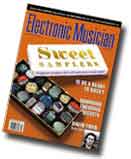|
|

Electronic Musician
by David Rubin
Oct 1, 2001
Samplers have been the traditional tools of choice for rendering the complexities of woodwind sounds. But hardware samplers are frequently hobbled by RAM restrictions, spawning presets based on a limited number of short, looped samples with few, if any, dynamic layers. To avoid those problems, composer and instrumentalist Dan Dean turned to the GigaSampler format. His Dan Dean Solo Woodwinds collection ($549) offers natural-sounding unlooped woodwind samples that beautifully exploit the power of NemeSys's GigaStudio software sampler.
Dan Dean Solo Woodwinds ships in a zippered nylon case filled with discs and a small but highly informative booklet. A separate CD is provided for each of the ten instruments in the collection: piccolo, flute, alto flute, bass flute, clarinet, bass clarinet, oboe, English horn, bassoon, and contrabassoon. You can buy the discs for $99 each.
Playtime
The instruments were recorded digitally in a relatively small room with a modest amount of natural reverb and no EQ. The samples are consistently clean, clear, and easy to work with in solo parts or in combinations. You can add additional reverb without muddying the sound if you need to create a larger concert setting, or you can use any sound as is for an up-close effect.
Each instrument was recorded with four basic performance techniques: legato with vibrato, legato without vibrato, staccato, and portato (short but not as short as staccato). Because vibrato is less commonly used with the clarinet and bass clarinet, vibrato presets are not provided for those instruments. That's too bad; a clarinet with vibrato could come in handy for solos in certain styles.
In addition to the four basic playing techniques, each instrument was recorded at different dynamic levels from pp to ff. The clarinets, contrabassoon, flute, and oboe are offered with an amazing six dynamic layers. The English horn has five layers; the rest have three or four. Having so many dynamic levels can impart a greater realism to the instruments as their timbres change from soft to loud. As you might expect, sampling each note of an instrument containing multiple dynamic levels yields some rather large presets, so the collection also includes limited versions to conserve memory.
Tone Controls
Dan Dean Solo Woodwinds becomes interesting when it combines the basic presets with GigaStudio's controller capabilities. For example, you can use the Mod wheel to add a slower or faster attack to either legato sound or to switch between playing techniques on the fly.
However, I much prefer using GigaStudio's key-switching feature, which is well implemented in the collection. It lets you do the same things as the Mod wheel does, but with a more definite feel. Two or more designated keys outside of the playing range let you change, in real time, from one playing technique to another. For example, having vibrato on all the time often seems unnatural because wind players seldom add vibrato to every note. With key switching, I can play a passage without vibrato and add vibrato only to the final note in a phrase. In a similar manner, I can play a string of staccato notes and play the final note sustained, or vice versa.
Several presets allow you to change from one patch or layer to another with Velocity switching. One of my favorite presets, however, uses key switching instead of Velocity switching to jump from layer to layer. It takes some practice to use effectively, but selecting layers independently of the Velocity opens some exciting possibilities.
For example, sometimes a note that appears frequently in a passage begins to sound unreal because it always sounds exactly the same — a common problem with sampled instruments. By changing layers (with key switching) while keeping the Velocity constant, you can change the sound of a note in a subtle way without making it louder or softer. Not all layers work for that technique, but you can certainly add variety that might not otherwise exist. The same technique also comes in handy with unison ensembles to keep the different instrument lines from sounding identical.
Sound Judgment
Overall, the instruments in Dan Dean Solo Woodwinds sound great. The alto and bass flutes sound especially lush; the English horn and oboe have a nice reedy timbre and a subtle vibrato. The clarinet is not quite as woody in the chalumeau register as I would like, but the instrument's six layers offer a good deal of control over its sound. The bass clarinet and low double reeds offer smooth, dark timbres at the bottom end.
With well over 4 GB of carefully crafted multisamples and hundreds of useful presets, Dan Dean Solo Woodwinds is clearly aimed at desktop musicians and orchestrators who take their wind instruments seriously.
Overall EM Rating (1 through 5): 5
|
|
 |
|
> Read the "Sonic Control" review.
> Read the "Samplepools" review.
|
|
|
|
James Newton Howard - Film Composer
|
|
"We started using the Dan Dean Solo Woodwinds as soon as we received them. They have replaced many of our other woodwind sounds. They are laid out logically and are well programmed. It is a fantastic collection!"
|
|
|
|
Ken Harrison - Composer
|
|
"Dan, I have just completed a project where I was able to use most of your solo woodwinds. With this addition to my sample library, my tracks aresounding more live and authentic than ever before. Producers are impressed because they think I actually hired "Live" players! Wow, I love this stuff! Can't wait for the "solo horns". Bring 'em on . . . quick!!"
|
|
|
|
Danny Pelfrey - Film Composer
|
|
"They're unbelievable! They replace everything else I've ever used! This library is going to make a great difference to my work."
|
|
|
|
David Newman - Film Composer
|
|
"They are great! I love that ability to manipulate the articulations... fantastic.... can't wait for the brass!
|
|



